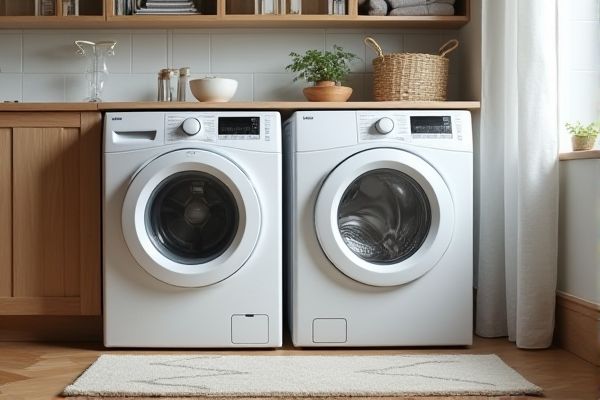
Compact laundry machines save space without compromising on performance, making them ideal for small apartments or limited laundry areas. Discover how choosing the right machine impacts your laundry routine by reading the rest of the article.
Table of Comparison
| Feature | Compact Laundry Machines | Standard Laundry Machines |
|---|---|---|
| Size | Small, space-saving (usually under 24 inches wide) | Larger, standard size (usually 27 inches wide) |
| Capacity | 4-6 kg (light to medium loads) | 7-12 kg (large loads) |
| Energy Efficiency | Typically energy-efficient, tailored for small loads | Varies, generally efficient for heavy usage |
| Installation | Flexible, ideal for apartments or small spaces | Requires dedicated laundry space |
| Price | Lower initial cost | Higher initial cost |
| Performance | Suitable for light to regular washing needs | Better for heavy fabrics and frequent use |
| Features | Basic to mid-range features | Wide range of advanced features available |
| Water Usage | Lower water consumption per cycle | Higher water consumption due to larger capacity |
Introduction to Compact and Standard Laundry Machines
Compact laundry machines offer a space-saving solution ideal for small apartments or limited laundry areas, providing efficient washing and drying capabilities without sacrificing performance. Standard laundry machines deliver higher load capacities and faster cycle times, making them suitable for larger households with frequent laundry needs. Understanding your space constraints and laundry habits helps determine whether a compact or standard machine best complements your routine.
Space Requirements: Compact vs Standard Models
Compact laundry machines require significantly less space, making them ideal for small apartments, condos, or homes with limited laundry areas, often measuring around 24 inches in width compared to the 27-30 inches typical of standard models. Standard laundry machines offer larger capacities but demand more floor space, which can limit installation options and reduce usable room for other household activities. Your choice between compact and standard models depends on available space constraints and laundry load needs, balancing efficiency with the physical footprint of the appliance.
Washing Capacity: Size and Load Considerations
Compact laundry machines typically offer washing capacities ranging from 1.5 to 2.5 cubic feet, suited for small loads and limited spaces. Standard laundry machines provide larger capacities, often between 3.5 to 5.0 cubic feet, accommodating bulkier items and family-sized laundry loads. Selecting between compact and standard models depends on available space, typical laundry volume, and the need for load efficiency.
Energy Efficiency and Water Usage Comparison
Compact laundry machines typically consume less energy and use significantly less water compared to standard laundry machines, making them ideal for conserving resources in smaller households or apartments. With advanced energy-efficient technologies such as inverter motors and eco-friendly wash cycles, compact units reduce your utility bills without compromising cleaning performance. Standard machines, while often offering larger load capacities, tend to have higher energy and water consumption rates, impacting overall efficiency.
Performance and Washing Effectiveness
Compact laundry machines deliver efficient cleaning performance ideal for small loads and limited spaces, using advanced technology to optimize water and detergent use. Standard laundry machines typically offer greater washing effectiveness for larger loads, with more robust cycles and higher capacity drums that handle heavy fabrics and stubborn stains better. Both types incorporate multiple wash settings, but standard machines generally provide superior agitation and spin speeds, enhancing overall cleaning results.
Installation and Placement Flexibility
Compact laundry machines offer increased installation and placement flexibility compared to standard models, as they fit easily into smaller spaces such as apartments, closets, or under counters. Their lightweight design and stackable options enable versatile configurations that optimize limited areas without sacrificing performance. Your choice of a compact unit allows for convenient laundry setups in homes with restricted space, enhancing overall functionality without extensive remodeling.
Noise Levels and Operating Features
Compact laundry machines typically produce lower noise levels, making them ideal for apartments and small living spaces where sound reduction is crucial. Standard laundry machines often feature advanced operating modes like multiple wash cycles, steam cleaning, and higher spin speeds, offering greater customization and efficiency. Noise insulation technologies vary, with compact models prioritizing quiet operation, while standard machines emphasize performance and versatile features.
Cost Analysis: Purchase and Long-term Maintenance
Compact laundry machines typically have a lower upfront purchase price, averaging $400 to $900, compared to standard machines which range from $700 to $1,200. Maintenance costs for compact units tend to be lower due to simpler components and less frequent repairs, while standard machines may incur higher long-term expenses driven by advanced features and larger capacity parts. Evaluating total cost of ownership over 5 to 10 years reveals compact models offer cost savings ideal for small households or limited spaces, whereas standard machines provide better efficiency for larger families despite higher initial and maintenance costs.
Ideal Users and Household Suitability
Compact laundry machines are ideal for individuals or small households living in apartments, dorms, or spaces with limited square footage, offering efficient cleaning while saving room. Standard laundry machines suit larger families or those with frequent, high-volume laundry needs, providing greater capacity and faster cycle times to handle bulk loads effectively. Your choice depends on space availability, laundry frequency, and load size requirements to ensure optimal household suitability.
Conclusion: Choosing the Right Laundry Machine
Choosing the right laundry machine depends on your space constraints and laundry needs. Compact laundry machines offer excellent efficiency for small living areas or apartments, while standard laundry machines provide larger capacity and faster cycles ideal for bigger households. Assess your daily laundry volume and available space to ensure your machine aligns perfectly with your lifestyle.
 homyna.com
homyna.com